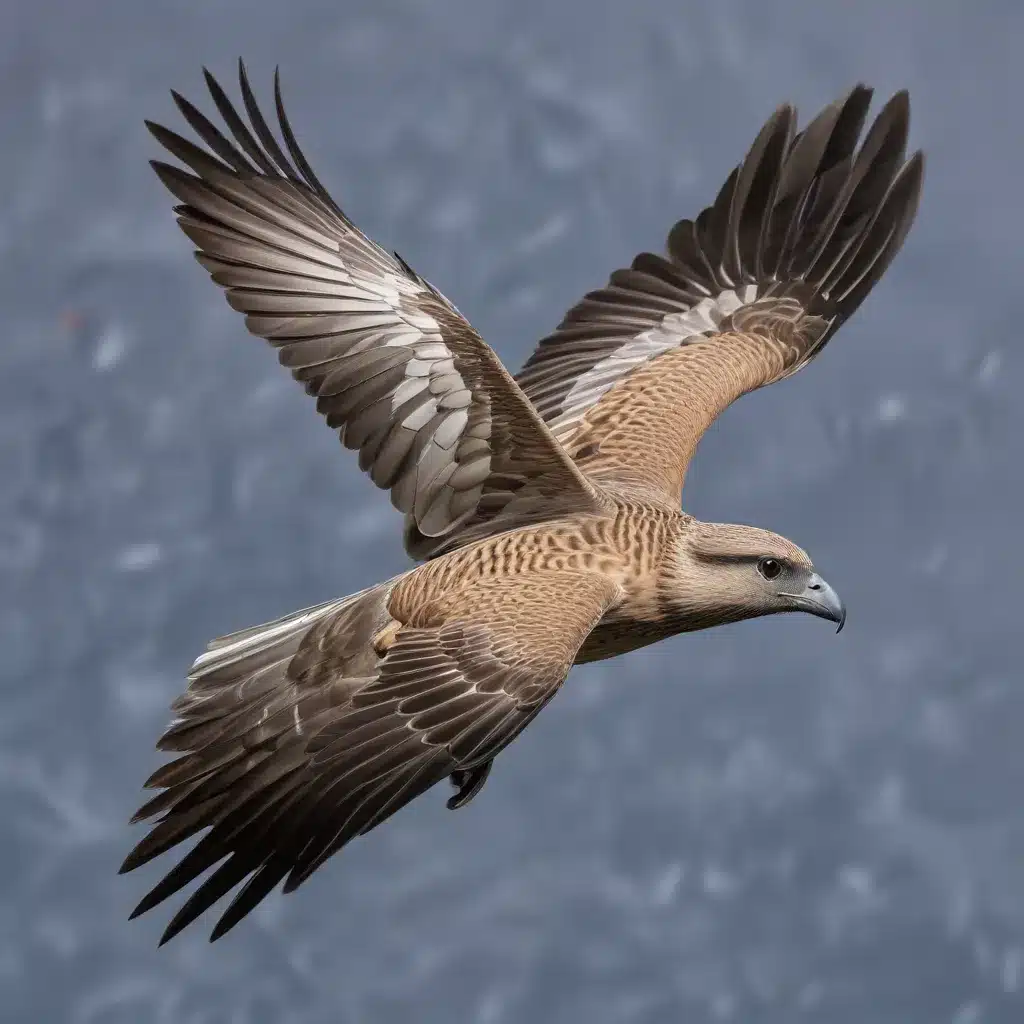
Avian Anatomy and Biomechanics
Birds are remarkable creatures, evolved over millions of years to master the skies. At the heart of this incredible feat lies their unique anatomy and biomechanics, meticulously adapted to the demands of powered flight. As an experienced avian caretaker, I’m excited to dive deep into the intricate physiology that allows our feathered friends to soar effortlessly.
Skeletal Structure of Birds
The avian skeletal system is a marvel of evolutionary engineering. Compared to their terrestrial counterparts, birds possess a remarkably lightweight yet sturdy frame, perfectly suited for the rigors of flight. Key adaptations include fused vertebrae, hollow and pneumatized bones, and a specialized pelvic girdle.
The fusion of vertebrae into a solid synsacrum enhances the structural integrity of the spine, allowing birds to withstand the immense forces generated during wing flapping. Meanwhile, the hollow, air-filled nature of their bones dramatically reduces overall body weight, enabling birds to achieve impressive lift-to-weight ratios. This ingenious skeletal design is further complemented by the presence of air sacs – extensions of the respiratory system that permeate even the smallest bones, promoting efficient oxygen delivery to the flight muscles.
Muscle Adaptations for Flight
Powering the complex movements of avian flight are the robust flight muscles, which make up a significant portion of a bird’s total body mass. The pectoralis, or “breast muscle,” is the primary driver of the powerful downstroke, accounting for up to 20% of a bird’s weight. In contrast, the smaller but equally crucial supracoracoideus muscle is responsible for the upward sweep of the wings.
These flight muscles are composed of a specialized blend of fast-twitch fiber types, enabling the rapid, high-intensity contractions necessary for flapping flight. Interestingly, hummingbirds, the smallest of all flying birds, possess an even higher proportion of these fast-twitch fibers, allowing them to sustain the remarkably high wingbeat frequencies required for their unique hovering abilities.
Avian Aerodynamics
Principles of Avian Flight
The ability of birds to defy gravity and soar effortlessly through the skies is a testament to the intricate principles of avian aerodynamics. At the heart of this phenomenon is the concept of lift, the upward force generated by the interaction between a bird’s wings and the surrounding air.
As a bird’s wings move through the air, they create a difference in pressure between the upper and lower surfaces of the wing. This pressure differential, combined with the curved shape of the wing (the airfoil), generates a net upward force that counteracts the pull of gravity, allowing the bird to achieve and maintain flight.
Wing Design and Airfoil Mechanics
The avian wing is a marvel of evolutionary engineering, with a design that seamlessly integrates form and function. The primary feathers, arranged in an overlapping pattern, create a smooth, cambered surface that is crucial for efficient lift generation. The secondaries, on the other hand, play a vital role in adjusting the wing’s shape and curvature, enabling birds to adapt their flight characteristics to suit various conditions.
The airfoil-like cross-section of a bird’s wing is another key feature that enhances its aerodynamic performance. This unique shape, with a gently curved upper surface and a flatter lower surface, creates a pressure differential that generates the necessary lift for flight. Interestingly, birds can further modify the shape of their wings by adjusting the positioning of their primary and secondary feathers, allowing them to fine-tune their aerodynamic properties as needed.
Lift and Thrust Generation
The generation of lift and thrust are the fundamental principles that allow birds to achieve and maintain flight. As the wings flap, they not only create the upward lift that counteracts gravity, but also generate the forward thrust necessary for sustained flight.
During the downstroke, the pectoralis muscles contract powerfully, driving the wings downward and generating the majority of the lift. The upstroke, facilitated by the supracoracoideus muscles, then provides the necessary thrust to propel the bird forward. This intricate interplay between lift and thrust, combined with the bird’s ability to adjust its wing shape and orientation, enables it to execute a wide range of aerial maneuvers, from graceful soaring to agile maneuvering.
Energetics of Avian Flight
Metabolic Demands of Flight
Powering the incredible feats of avian flight is an equally remarkable physiological system. The energy demands of flight are staggering, with some species capable of sustaining high-intensity flapping for hours on end during long-distance migrations.
To meet these extraordinary energy requirements, birds have evolved a suite of adaptations, including a highly efficient cardiovascular system and a specialized metabolism that prioritizes the use of lipids as a primary fuel source. The avian heart, proportionally larger than that of their terrestrial counterparts, is capable of delivering vast quantities of oxygen-rich blood to the flight muscles, ensuring a steady supply of energy.
Efficiency and Energy Expenditure
Despite the impressive metabolic capabilities of birds, the energetic costs of flight are still substantial. Researchers have estimated the efficiency of avian flight muscles to be in the range of 13-23%, a significant improvement over the 2-3% efficiency observed in insect flight.
This enhanced efficiency can be attributed to several factors, including the optimization of muscle fiber composition, the strategic use of lipids as a fuel source, and the integration of advanced aerodynamic principles into wing design. Additionally, the ability of birds to modulate their flight patterns, seamlessly transitioning between flapping, soaring, and gliding, allows them to conserve energy and optimize their overall energetic expenditure.
Avian Flight Modes
Flapping Flight
Flapping flight, the most common and iconic mode of avian locomotion, is a marvel of biomechanical synchronization. As the pectoralis muscles powerfully contract, driving the wings downward, the supracoracoideus muscles then lift the wings back up, creating a rhythmic cycle of lift and thrust generation.
This flapping motion is precisely tuned to the specific flight requirements of each bird species, with factors such as wing shape, body size, and muscle composition all playing a crucial role in determining the optimal flapping frequency and amplitude. Smaller birds, like hummingbirds, often exhibit exceptionally high wingbeat frequencies to achieve the lift necessary for their unique hovering abilities.
Soaring and Gliding
While flapping flight is the primary mode of propulsion, birds have also evolved the remarkable ability to conserve energy through soaring and gliding. By taking advantage of thermal currents and updrafts, birds can effortlessly gain altitude and maintain flight with minimal muscle exertion.
The aerodynamic design of the avian wing, with its efficient airfoil shape and adjustable feather positioning, allows birds to harness these invisible air currents, expertly maneuvering through the skies with minimal energy expenditure. This skill is particularly crucial for long-distance migrations, where birds must cover vast expanses of terrain while conserving precious energy reserves.
Migrating and Long-Distance Flight
The remarkable feats of avian migration never cease to amaze. Each year, countless bird species undertake extraordinary journeys, covering thousands of miles to reach their breeding or wintering grounds. These long-distance flights require a delicate balance of metabolic efficiency, aerodynamic prowess, and exceptional endurance.
To fuel their migrations, birds have evolved a specialized metabolism that prioritizes the use of lipids as a primary energy source. This allows them to maintain a steady supply of energy throughout their arduous journeys, while minimizing the buildup of metabolic waste products that could impair their performance.
Interestingly, the ability of birds to seamlessly transition between flapping, soaring, and gliding flight modes is a key adaptation that enables them to conserve energy and complete these remarkable migrations. By carefully monitoring environmental cues and adjusting their flight patterns accordingly, birds can optimize their energy expenditure and reach their destinations with remarkable consistency.
Exploring the intricate physiology of avian flight is a true marvel, revealing the culmination of millions of years of evolutionary refinement. From the lightweight, yet sturdy skeletal structure to the highly efficient muscle adaptations and aerodynamic wing design, birds have mastered the skies in a way that continues to inspire awe and wonder. As an experienced avian caretaker, I’m privileged to witness these feathered wonders in action, and I hope that this deep dive into avian flight physiology has provided you with a greater appreciation for the incredible feats of our winged companions. Be sure to visit Mika Birds Farm to learn more about the fascinating world of avian care and conservation.


